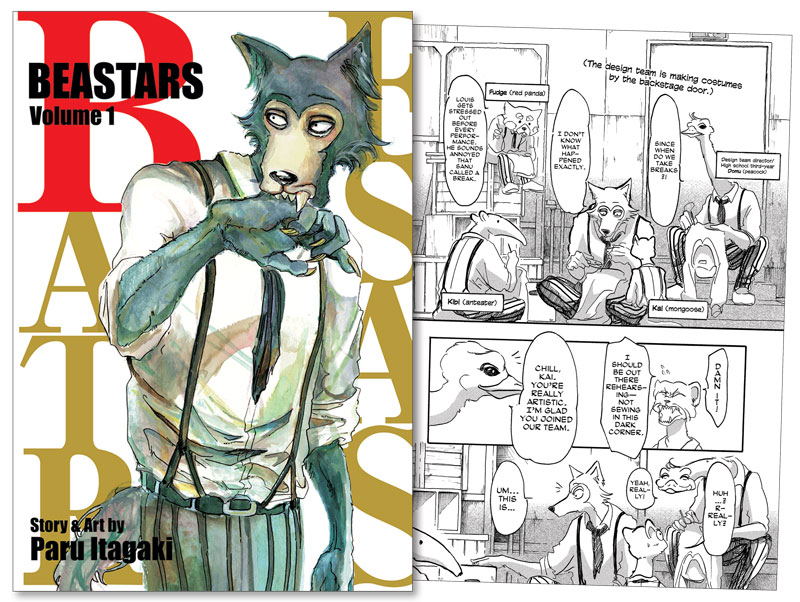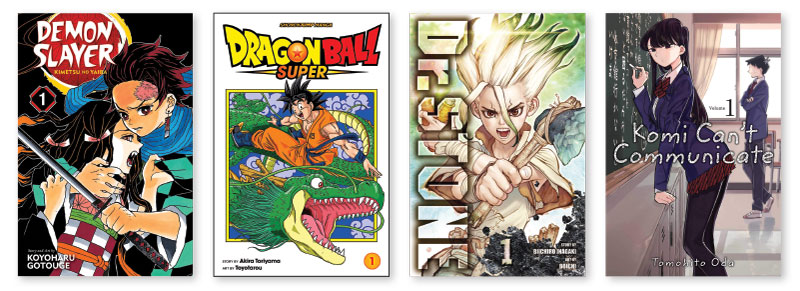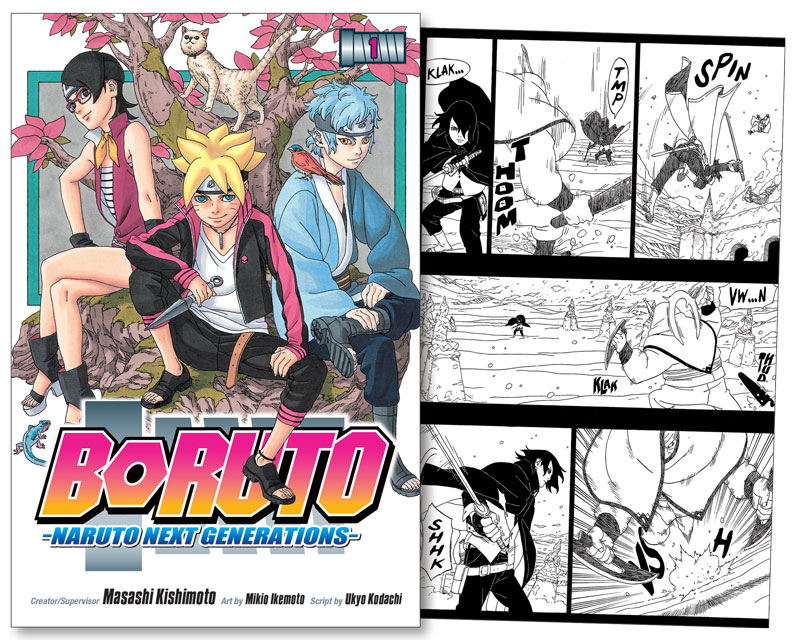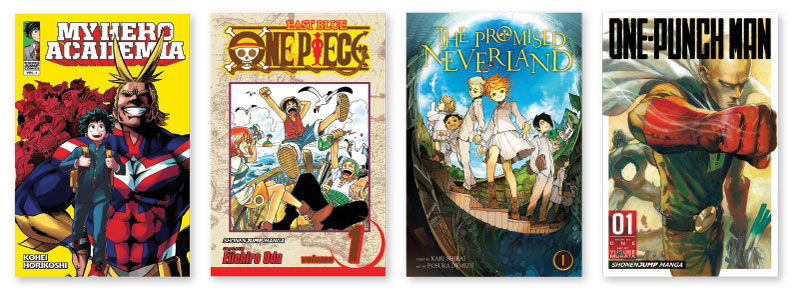10 Shonen Manga Must-Reads | Mondo Manga
Lively action-adventure tales that typically feature large casts of memorable characters, shonen manga is the best-selling manga in the United States. Brigid Alverson names her top picks in shonen manga, most for grades 7 and up.
 |
“Beastars”All Series art courtesy of Viz Media |
 The best-selling manga in the United States are almost all shonen series, and all of those top titles are published by Viz—which, as we will see, is no coincidence.
The best-selling manga in the United States are almost all shonen series, and all of those top titles are published by Viz—which, as we will see, is no coincidence.
“Shonen” is Japanese for “boy,” and shonen manga is targeted at teenagers, although many series are popular with teenage girls (and older readers) as well, both in the United States and in Japan. The shonen category encompasses different genres: science fiction, action, mystery, romance. When Americans speak of “shonen manga,” however, they are often referring to action-adventure tales with a bit of comedy mixed in, which is the most popular type of story.
In Japan, the best-selling manga magazine is Weekly Shonen Jump, which has dominated the market for decades and is home to such classic manga series as “Naruto,” “One Piece,” and “My Hero Academia.”
 Viz has emerged as a manga powerhouse in North America, in part because the publisher of Weekly Shonen Jump is a parent company of Viz, granting it direct access to many of the most popular series in Japan. Viz has published an American version of Shonen Jump for years, first as a paper magazine, then as a digital publication, and now as an app. Viz also uses the Shonen Jump imprint for many of its series, whether or not they actually run in the Japanese magazine.
Viz has emerged as a manga powerhouse in North America, in part because the publisher of Weekly Shonen Jump is a parent company of Viz, granting it direct access to many of the most popular series in Japan. Viz has published an American version of Shonen Jump for years, first as a paper magazine, then as a digital publication, and now as an app. Viz also uses the Shonen Jump imprint for many of its series, whether or not they actually run in the Japanese magazine.
Shonen manga with the broadest appeal generally have the same features as other popular stories. Shonen heroes are often underdogs or, at best, average guys who have a special ability or destiny—much like Harry Potter. Most series feature a large cast of memorable characters, which not only makes the stories more interesting but also allows for lots of cosplay. A few factors are specific to manga, however.
Anime, which has a wider audience than manga, often drives the popularity of a series, and if the story is further along in the manga, readers may cross over to see what happens next. Long-running series usually have a number of story arcs, which correlate with anime seasons, so the story refreshes from time to time. The most popular type of manga, shonen is commonly pirated. Numerous “scanlation” sites carry bootleg translations or even outright scans of American editions. In response, manga publishers have stepped up their digital presence. For Shonen Jump, Viz offers the first three chapters and the most recent chapters on its website and apps for free. For other series, it offers the first chapter. In addition, all series are available digitally on ComiXology, Kindle, and the Viz apps. And the Shonen Jump series are also available on Viz’s Shonen Jump app, which offers unlimited reading for $1.99 a month.
With that, here’s a look at the best-selling shonen manga in American bookstores. These series are ongoing in Japan.
“Beastars.” Paru Itagaki. Viz (Viz Signature).
Gr 10 Up–Cherryton Academy is a school for anthropomorphized animals. The carnivores and the herbivores, predators and prey, are housed in different dorms but mingle in classes and clubs, which, predictably, leads to tension.
The story opens with the brutal murder of a student in the Drama Club, and the herbivores suspect a carnivore is the culprit. Legoshi, a gray wolf, is the chief suspect, but he seems like a gentle, quiet guy, and he has a crush on Haru, a dwarf rabbit (and a friend of the murdered classmate). The friction between the groups and the characters’ struggle to keep their animal instincts in check have obvious parallels in the real world, and Itagaki’s skillfully drawn characters are human enough to make them recognizable as people one might encounter in real life. Launched just last year, the series quickly built a following. Volume 6 released in mid-May, and the anime started its Netflix run in March.
Read: Free Comics and Resources on COVID-19 in Graphic Form
“Boruto: Naruto Next Generations.” Masashi Kishimoto. Script by Ukyo Kodachi. illus. by Mikio Ikemoto. Viz (Shonen Jump).
Gr 7 Up–“Naruto” was the best-selling manga in the U. S. during its run, which concluded in 2014 with Volume 72. “Naruto” was in many ways the classic shonen manga: The hero, Naruto, was the village outcast, but he trained hard to become a ninja, went on numerous missions with a group of loyal friends, and ultimately became the Hokage, or leader of his village. “Boruto” is the story of his son, who has special talents and adventures of his own. Kishimoto, creator of “Naruto,” supervises this series, and Ikemoto was his chief assistant. So “Boruto” has a similar feel to the original. The first story follows the plot of Boruto: Naruto the Movie, and a television anime picks up the story after that. There are eight volumes available in English so far, with Volume 9 publishing in August.

“Demon Slayer: Kimetsu no Yaiba.” Koyoharu Gotouge. Viz (Shonen Jump).
Gr 7 Up–In this story set in early 20th-century rural Japan, teenager Tanjiro supports his family by selling charcoal after the death of his father. One night while he is away, demons slaughter his family, leaving only his younger sister Nezuko—who has become a demon. With some vestiges of human emotion, she seems to recognize that Tanjiro is her brother. The series follows Tanjiro’s quest to avenge his family and find a way to make his sister human again. The manga and anime have striking visuals; Gotouge uses hatching and patterns, departing from the smoother effect favored by other manga creators; Tanjiro’s checked coat is particularly recognizable. Not surprisingly, this series is popular with cosplayers. There are 12 volumes available so far.
“Dragon Ball Super.” Akira Toriyama. illus. by Toyotarou. Viz (Shonen Jump).
Gr 7 Up–Akira Toriyama’s “Dragon Ball” was one of the first manga/anime series to come to English-language audiences and one of the most popular as well. The series followed the adventures of Son Goku, who grows from a boy to a man as he masters the martial arts, channels his own super strength, and seeks out the seven Dragon Balls. In “Dragon Ball Super,” Goku has defeated the villain Boo, saved Earth, and settled down to an ordinary life as a farmer. But the God of Destruction, Beerus, breaks the monotony when he arrives to challenge Goku. To fight Beerus, Goku channels the energy of five other heroes and becomes the Super Saiyan God, which endows him with new powers and sends him off on a new set of adventures, battling old and new enemies throughout the universe. In other words, if you liked “Dragon Ball,” you’ll like “Dragon Ball Super.” Volume 9 debuts in early June, and there is an anime as well.
 |
“Boruto: Naruto Next Generations” |
“Dr. Stone.” Riichiro Inagaki. illus. by Boichi. Viz (Shonen Jump).
Gr 7 Up–High school student Taiju is about to confess his love for classmate Yuzuriha when a sudden flash of light fills the sky and all humanity turns to stone. Taiju breaks from his stone cocoon, 3,700 years later, to learn that his genius friend Senku has already emerged and is busy re-creating all of 21st-century technology from this literal Stone Age. Together they revive Yuzuriha, but when conflict and violence enter their Eden, Senku and Taiju split up and go in different directions to evade their antagonist. Senku finds a village where people escaped petrification, so they have a primitive lifestyle but also some knowledge of science. What makes this series so fun is watching Senku make gunpowder, soap, even a bottle of cola out of materials at hand. Senku applies real scientific methods, definitely of the “don’t try this at home” variety. Volume 11 was released in May, and there is an anime, too.
Read: 7 Graphic Novels That Offer Powerful Mirrors & Windows for Teens
“Komi Can’t Communicate.” Tomohito Oda. Viz (Shonen Sunday).
Gr 7 Up–This is the only romance on the list, and it’s a comedy. Komi is incredibly beautiful and she never speaks, so her classmates find her elegant and standoffish. In fact, she’s extremely shy, as her classmate Tadano discovers. Tadano is pretty shy himself, and his initial goal was to get through high school without being noticed, but when he finds out about Komi’s problem, he is determined to help her overcome it by making 100 friends. That takes them both way out of their comfort zone. And hilarity ensues. This manga has been a best seller since the first volume came out in mid-2019. The artwork is smooth and easy to follow, and the story is broken into very short chapters, so it’s easy to dip in and out. Volume 7 is scheduled for June.
“My Hero Academia.” Kohei Horikoshi. Viz (Shonen Jump).
Gr 7 Up–Currently the best-selling manga in America, “My Hero Academia” is set in a world where more than half the population is born with “quirks,” or specialized superpowers. Izuku Midoriya is born quirkless, and on of his schoolmates, Katsuki Bakugo, mocks him. That all changes when the most powerful superhero, All Might, bestows his power on Midoriya and has him attend UA, an elite training school for superheroes. There’s a large and varied cast, plenty of humor, and battles to boot. Best of all, Horikoshi gets free rein to create bizarre heroes and outlandish villains. Volume 24 publishes in June, and there is an anime series. Spin-offs include “My Hero Academia Vigilantes,” a manga series set in the same world with different characters, and the four-panel parody manga “My Hero Academia: Smash!!”

“One Piece.” Eiichiro Oda. Viz (Shonen Jump).
Gr 7 Up–Although “One Piece” is not as popular in the U. S. as in Japan, it does have a devoted fandom in North America. The series centers on Luffy D. Monkey and the Straw Hat Pirates, who roam the Earth in search of the mythical treasure One Piece. This takes them to strange lands and leads them into epic battles with entire armies, all filled with outsize personalities and crazy details. Even after 93 volumes, Oda’s still shines. In this shonen series, a lot of the fun comes from the sheer variety and weirdness of the characters. But “One Piece” has a strong friendship theme, which also accounts for reader loyalty. This long-running series has an anime, and both the anime and the manga are broken into discrete story arcs. Viz published Volume 93 in April.
“One-Punch Man.” ONE. illus. by Yusuke Murata. Viz (Shonen Jump).
Gr 7 Up–Bored with life, a young man, Saitama, sets out to become a superhero. He trains so hard that his hair falls out, but he is so strong that he can defeat any villain with a single punch. So he’s still bored. Saitama and his cyborg sidekick, Genos, join a superhero guild and are tasked whenever supervillains attack their city. ONE and Murata delight in creating a huge cast of heroes and villains, some totally badass, some ridiculous (such as Pineapple, whose costume is festooned with giant pineapple rings). Blending action and comedy, “One-Punch Man” is both a great superhero comic and a loving parody of the genre. Nineteen volumes are currently available in English, and there is an anime.
“The Promised Neverland.” Kaiu Shirai. illus. by Posuka Demizu. Viz (Shonen Jump).
Gr 10 Up–The orphans of Grace Field House lead a seemingly idyllic existence, with good food, spacious grounds to play on, and a loving “Mom.” Yet they all have numbers tattooed on their necks. In fact, as the three oldest and smartest children, Emma, Norman, and Ray, discover one night, the orphanage is actually a farm, and the children are being raised as meat. Those who leave are not going to foster families but to a monster’s dinner table. So the three plot their escape. Emma insists on rescuing all of the children, which Norman and Ray fear will be impossible. This plays out as a cat-and-mouse game with Mom. Once the orphans escape, the world around them is unrelentingly hostile. The art is beautiful and detailed, but there are some gruesome sequences; the first volume includes disturbing images of a young girl who has been killed by the monsters. For those who can handle that, it’s a great action/suspense story. Volume 15 and an anime arrive in June.

RELATED
Meet Me on Mercer Street
Lucky Scramble
The Night Librarian
Brownstone
The job outlook in 2030: Librarians will be in demand
The job outlook in 2030: Librarians will be in demand
ALREADY A SUBSCRIBER? LOG IN
We are currently offering this content for free. Sign up now to activate your personal profile, where you can save articles for future viewing





Add Comment :-
Comment Policy:
Comment should not be empty !!!